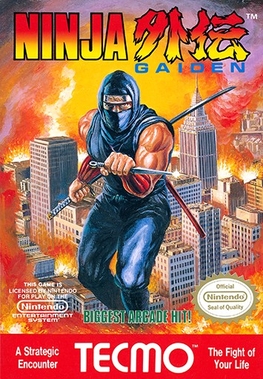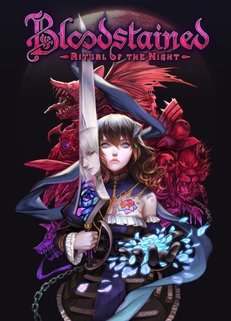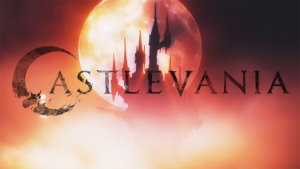
Castlevania, known in Japan as Akumajō Dracula, is a gothic horror action-adventure video game series and media franchise about Dracula, created and developed by Konami. It has been released on various platforms, from early systems to modern consoles, as well as handheld devices such as mobile phones. The franchise has expanded into several spin-off video games and other media, including comic books and an animated television series.

Adrian Fahrenheit Țepeș, better known as Alucard, is a character in Konami's Castlevania series of video games. His first appearance in the series was in the 1989 game Castlevania III: Dracula's Curse, but he is best known for his role in the critically acclaimed Castlevania: Symphony of the Night, released in 1997. His design in Symphony of the Night was created by Ayami Kojima, marking her first contribution to the Castlevania franchise.

Castlevania II: Simon's Quest is a 1987 action role-playing game developed and published by Konami. It was originally released in Japan in 1987 for the Famicom Disk System, and in North America in 1988 for the Nintendo Entertainment System. It is the second Castlevania game released for the NES, following the original Castlevania (1986). Set seven years after the events of the first installment, the player once again assumes the role of vampire hunter Simon Belmont, who is on a journey to undo a curse placed on him by Dracula at the end of their previous encounter. Dracula's body was split into five parts, which Simon must find and bring to the ruins of Castle Dracula in order to defeat him. The game deviates from the traditional platforming of its predecessor, incorporating role-playing and open world elements.

Castlevania III: Dracula's Curse is an action-adventure platform video game developed and published by Konami for the Nintendo Entertainment System. It was released in Japan in 1989, and in North America in 1990, and in Europe by Palcom in 1992. It was later released on the Virtual Console for the Wii, Nintendo 3DS, and Wii U.

Castlevania: Curse of Darkness is an action-adventure game, part of the Castlevania franchise. It is the second 3D Castlevania title developed by Konami Computer Entertainment Tokyo, released in 2005 following Castlevania: Lament of Innocence and was available for PlayStation 2 and Xbox in all regions except Japan, where the game was only available on PlayStation 2. Curse of Darkness received mixed reviews, common praise was directed towards its combat system, music, content, and replay value, while criticism fell towards its story, characters, repetitive level-design and gameplay.

Castlevania, also referred to as Castlevania 64, is a 1999 action-adventure video game developed by Konami's Kobe branch for the Nintendo 64. An expanded version of the game, Castlevania: Legacy of Darkness, was released later in the same year.

Super Castlevania IV is a platform video game developed and published by Konami for the Super Nintendo Entertainment System. It has been re-released multiple times, including for the Super NES Classic Edition.

Castlevania: Bloodlines, known in Japan as Vampire Killer and in PAL regions as Castlevania: The New Generation, is a platform game developed and published by Konami in 1994 for the Sega Genesis, part of the Castlevania series. A vampire named Elizabeth Bartley is orchestrating the beginning of World War I as a sacrificial war to bring her uncle, Dracula, back to life. Players take on the role of Quincey Morris' son, John, and his friend Eric Lecarde to take up the fight against evil.

Koji Igarashi is a Japanese video game producer, programmer, writer, and creative director. In 2009, he was chosen by IGN as one of the top 100 game creators of all time.

Ninja Gaiden, released in Japan as Ninja Ryūkenden and as Shadow Warriors in Europe, is an action-platform video game developed and published by Tecmo for the Nintendo Entertainment System. Its development and release coincided with the beat 'em up arcade version of the same name. It was released in December 1988 in Japan, in March 1989 in North America, and in August 1991 in Europe. It has been ported to several other platforms, including the PC Engine, the Super NES, and mobile phones.

Castlevania: Order of Ecclesia is a 2008 action role-playing game and the third Nintendo DS installment of the Castlevania franchise. Directed by Akihiro Minakata, with producer Koji Igarashi returning. The plot involves Shanoa, who is part of an organization set to defeat Dracula after the Belmont clan has vanished.

Castlevania Judgment is a 3D fighting video game developed by Eighting and published by Konami for the Wii. The game is based on the Castlevania series of games, and is the series' first fighting game.

Castlevania, known in Japan as Akumajō Dracula, is a platform game developed and published by Konami for the Family Computer Disk System video game console in Japan in September 1986. It was ported to cartridge format and released in North America for the Nintendo Entertainment System (NES) in May 1987 and in Europe in 1988. It was also re-issued for the Family Computer in cartridge format in 1993. It is the first game in Konami's Castlevania video game series.

Metroidvania is a sub-genre of action-adventure games and/or platformers focused on guided non-linearity and utility-gated exploration and progression. The term is a portmanteau of the names of the video game series Metroid and Castlevania, based on the template from Metroid (1986), Castlevania II (1987), Super Metroid (1994), and Castlevania: Symphony of the Night (1997).

Bloodstained: Ritual of the Night is a Metroidvania-styled video game developed by Japanese indie studio ArtPlay and published by 505 Games. The game's development was led by former Castlevania series producer Koji Igarashi and is considered a spiritual successor to the series. The game was released for PlayStation 4, Windows, Xbox One, and Nintendo Switch, in June 2019, for Amazon Luna in October 2020, for Android and iOS in December 2020, and for Stadia in July 2021.

Castlevania is an American adult animated dark fantasy action television series created and written by Warren Ellis for Netflix, and is produced by Frederator Studios's Kevin Kolde and Fred Seibert and Shankar Animation's Adi Shankar. Based on the Japanese video game series of the same name by Konami, the first two seasons adapt the 1989 entry Castlevania III: Dracula's Curse and follow Trevor Belmont, Alucard and Sypha Belnades as they defend the nation of Wallachia from Dracula and his minions. Additionally, characters and elements from the 2005 entry Castlevania: Curse of Darkness are featured beginning in the second season, and Alucard's backstory is drawn from the 1997 entry Castlevania: Symphony of the Night. The art style is heavily influenced by Japanese animation and Ayami Kojima's artwork.

Bloodstained: Curse of the Moon is a 2018 platform game developed and published by Inti Creates. It is a companion title to developer ArtPlay's 2019 game Bloodstained: Ritual of the Night and was conceived to fulfill the promise for a retro-style accompaniment to Ritual of the Night after its Kickstarter campaign exceeded crowdfunding goals. Curse of the Moon follows Zangetsu, a cursed swordsman hunting down demons for revenge, as well as three other playable characters named Miriam, Alfred and Gebel. It features an 8-bit aesthetic and gameplay style similar to Castlevania games on the Nintendo Entertainment System (NES), particularly Castlevania III: Dracula's Curse (1989).

Simon Belmont is a fictional character who serves as the first protagonist to appear in the Castlevania series. He appears in Castlevania, Vampire Killer, Haunted Castle, Castlevania II: Simon's Quest, Super Castlevania IV, and Castlevania Chronicles, and acts as a supporting character in Castlevania Judgment and Castlevania: Harmony of Despair. He also appeared as a playable character in DreamMix TV World Fighters and Super Smash Bros. Ultimate. Simon has received positive reviews from critics.

Gal Guardians: Demon Purge is a 2023 platform video game developed and published by Inti Creates. It is a spinoff of Gal Gun.



















